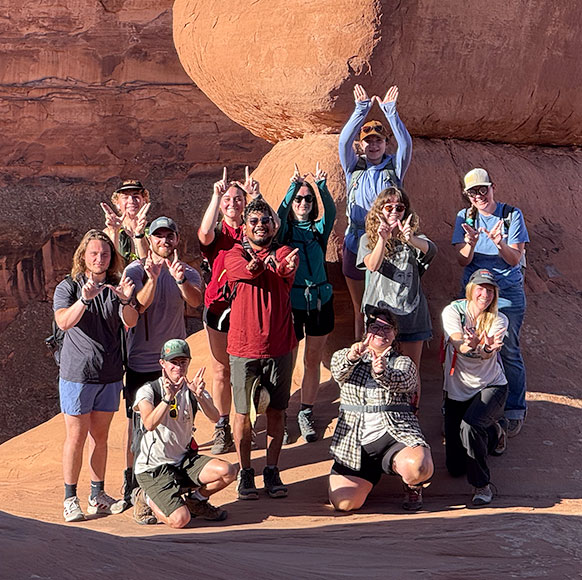UW Students Complete Geologic Systems Field Course in Moab for Energy Interpretation
Published October 10, 2025

Participants in the recent UW field course in Moab, Utah, are, from left: students Titus Timbers, Austin Quillinan, Jack McKinley, Logan Gray, Rachel Bryan, Aditya Srivastava, Phoebe Futcher, Abigail Mensch, Cass Lolley, Lucy Cooper, Harper Pollock and Center for Economic Geology Research Assistant Director Autumn Eakin. (School of Energy Resources Photo)
Students at the University of Wyoming recently completed a one-credit field course
in Moab, Utah, to study rock formations that are direct analogs to those being explored
for carbon management in Wyoming.
Open to all UW students and led by Autumn Eakin, assistant director of the Center
for Economic Geology Research (CEGR) in the School of Energy Resources (SER), the
course focused on understanding the geological properties of sedimentary rock layers
that could potentially store vast amounts of captured carbon dioxide.
The Moab region offers exceptional exposures of rock units that share similar age
and depositional settings with key formations found deep in the subsurface across
Wyoming. UW researchers and industry partners are investigating these formations for
their suitability as storage reservoirs.
“Field geology provides the foundation for observational and applied learning, helping
us connect what we can directly observe with what we must infer in the subsurface,”
Eakin says. “Outcrop scale and continuity give us a unique window into natural systems
and processes.”
Over the course of five days, students in the energy resources management and development
(ERMD) degree program in SER, as well as graduate students from the Department of
Geology and Geophysics, were challenged to consider how fluids move through the subsurface
and what happens when they encounter a barrier.
In addition to the practical ability to visualize precisely how fluids move in connected
or compartmentalized hydraulic systems, students in the course learned to identify
and evaluate different barriers to fluid flow, whether these are structural discontinuities,
such as a fault, or features related to the stratigraphic architecture, such as depositional
facies changes or a change in rock type.
The course offered distinct and significant benefits for both demographics of students.
For the aspiring land students, the field experience provided a vital, practical understanding
of subsurface reservoir geology, which is essential for determining mineral rights,
assessing lease viability, and negotiating surface and subsurface access for carbon
sequestration projects.
Geology students, on the other hand, benefited from applying advanced theoretical
knowledge to real-world, accessible analog outcrops, allowing them to better assess
subsurface uncertainties in geologic modeling.
“I had a great time on SER’s recent field course,” says Austin Quillinan, a junior
from Laramie in the ERMD program with a concentration in professional land management
as well as environment and natural resources through Haub School of Environment and
Natural Resources. “As a landman student, getting a dedicated education in physical
rock and structural geology was a huge benefit. Professor Eakin did an excellent job
of taking us to places that significantly aided our understanding of hydrocarbon reservoirs
and fault systems above the surface.”
Jack McKinley, a senior from Oxford, Ohio, in the ERMD program with a concentration
in energy and environmental systems, shares a similar experience.
“I had a fantastic time during the field course in Moab,” McKinley says. “Professor
Eakin provided a great introduction to fault seal analysis and showed how studying
surface geology can help us understand subsurface geology in other regions. It was
the perfect balance of learning, exploration and fun.”
The practical field study significantly enhanced the students’ ability to assess and
mitigate geological risk associated with carbon management, as well as in oil and
gas exploration and mineral development.
“It’s so exciting and rewarding to teach about natural systems in natural settings,” Eakin adds. “Exploring these systems ‘in the wild’ gives students a chance to think big picture, to make connections between what we can see at outcrop scale versus what we cannot see in the subsurface, and, hopefully, will inspire them to continue learning and exploring.”

